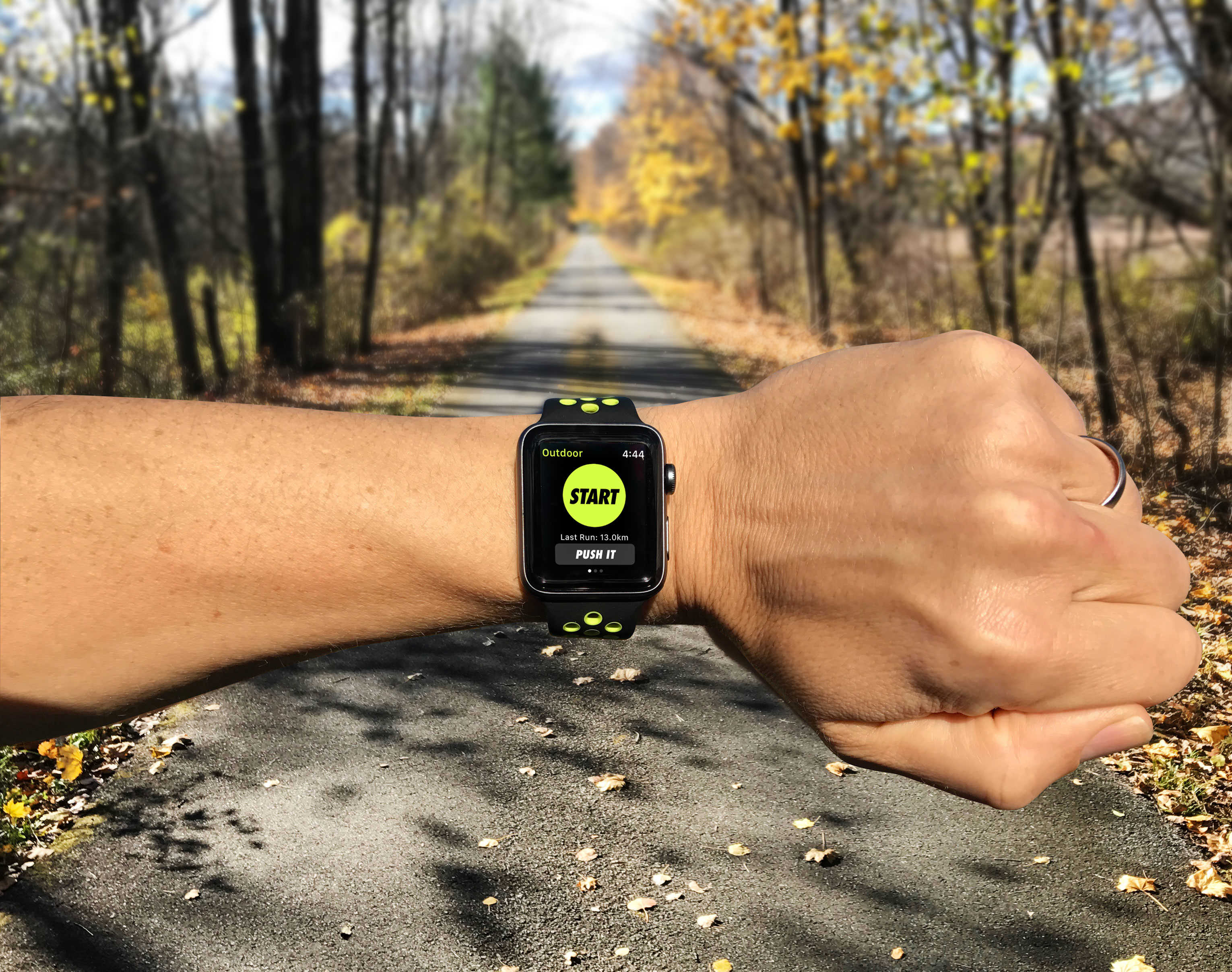With the launch of a GPS watch, and a renewed Nike partnership, Apple is getting serious about targeting runners. So is Apple Watch Series 2 the perfect running partner that Cupertino promises?
As an avid runner myself, I was keen to find out. Over the past couple of months, I’ve been training for the TCS New York City Marathon, and I took my Apple Watch Series 2 with me every step of the way — right up to the finish line in Central Park last week. Here’s how it measured up.
How I tested Apple Watch Series 2
Unlike most running watches, Apple Watch Series 2 does not just rely on its built-in GPS to follow your running route. It can also get assistance from your iPhone’s GPS. This helps save battery and boost accuracy. But the whole advantage of having built-in GPS is that you should be able to leave your iPhone behind when you go for a run. So in all my testing for this review, I ensured that my iPhone was out of range.
Apple offers two main variants of its Series 2 watch: standard and Nike-branded models. I bought and tested both, but found no significant difference between them in terms of features and accuracy.
I used Apple’s Workout app in most of my testing, but I also tried out the Nike Run Club app that is included with the Nike model.
The running watch of my dreams
My fondness for Nike+ Running goes back a long way. The first GPS running watch I ever owned was the Nike SportWatch GPS, which I reviewed for Cult of Mac back in 2011.
I knew I wanted a Nike Apple Watch long before it was even announced. Last year I wrote an article with mockups suggesting that Apple should release an “Apple Watch Nike Edition” featuring built-in GPS, Nike-designed bands, custom watch faces and the Nike+ app built in. And that is exactly what Cupertino has done. So to say that I was predisposed to like the new watch is an understatement.
Running watches are not known for their sartorial elegance. But the combination of Nike and Apple styling makes this the best-looking wearable I’ve ever seen. It looks so good, in fact, that I have taken to wearing it most of the time, saving my fancier steel link bracelet model for special occasions. I can’t think of any other running watch I’d be happy to wear all the time like that.
The only minor gripe I have about the design is the color. Nike calls it’s trademark fluorescent greeny-yellow “Volt.” This color is used on the watch face and the strap. In daylight, the colors match perfectly. But in artificial light, the screen appears green while the strap looks yellow, which creates an ugly color-clash. Maybe a future model could use Apple’s True Tone technology from iPad Pro to match the color of the display to the lighting environment.
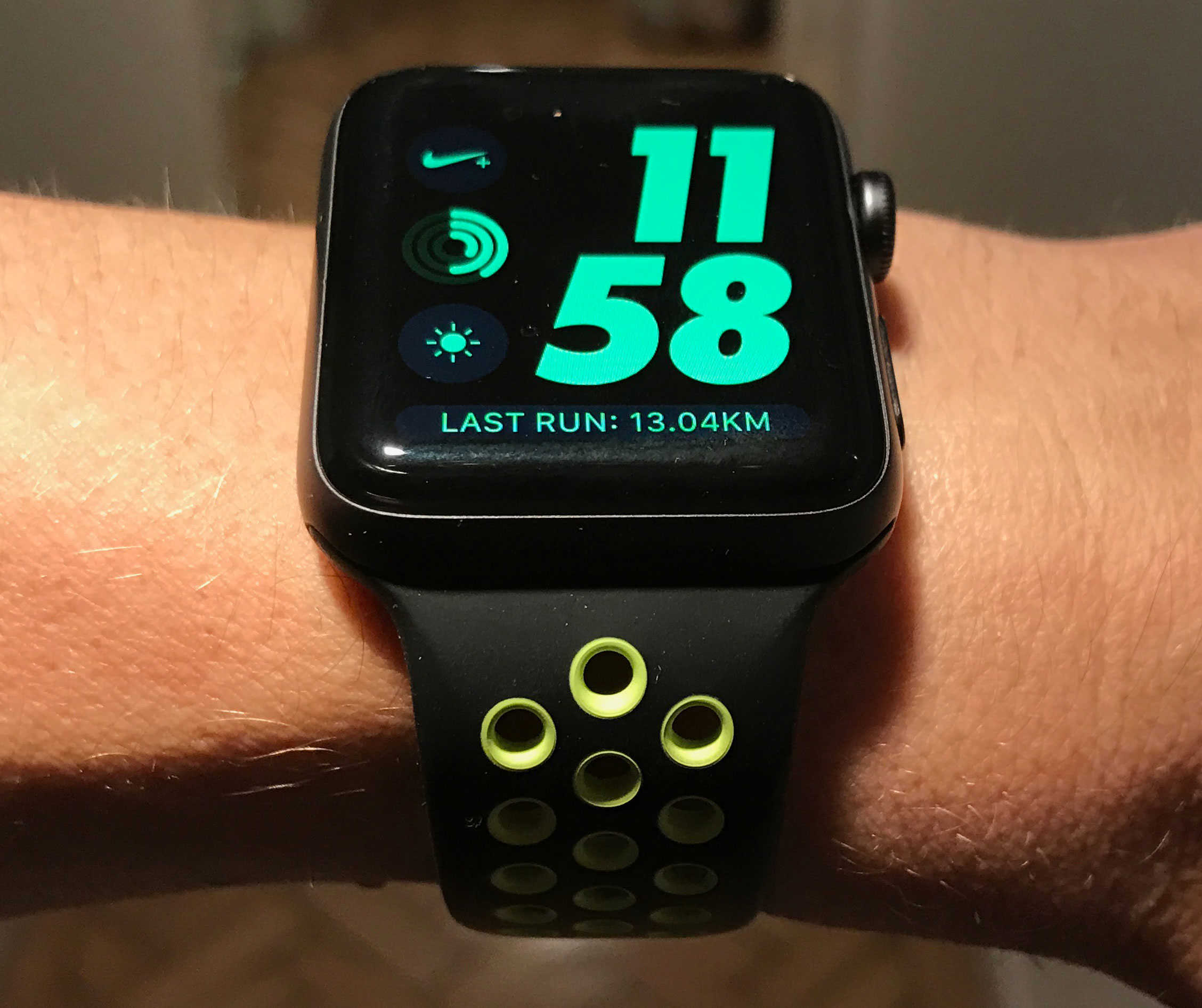
Photo: Graham Bower/Cult of Mac
But there is more to a great running watch than its looks. If you are serious about your running, then you want to be sure that your watch is tracking all your hard work accurately.
Time to take my Apple Watch for a run
After taking my new Apple Watch Series 2 for a few runs, I soon realized that it was giving me significantly different distance estimates than I get from my trusty TomTom Runner 2. I was not entirely surprised by this, because I had read Engadget’s Apple Watch review, which reported that distance and pace estimates varied from the reviewer’s Garmin.
The trouble with this kind of comparison is that you can’t be sure which watch is right. Maybe Engadget’s Garmin and my TomTom were always off the mark, and Apple Watch is in fact more accurate.
The gold-standard test for running watch accuracy
I decided to get scientific and subject both watches to a more objective test. So I went to my local running track, where distances are measured out precisely.
A standard running track is 400 meters (1,312.3 feet), so 2.5 laps is a kilometer. To test the watches, I performed six separate 1 kilometer runs, wearing my Apple Watch Series 2 on one wrist and my TomTom on the other. For each run, I started a new workout on both watches at the start line, and ended it at the finish line.
The results surprised me. Apple Watch turned out to be more accurate on all six tests. By how much? To answer that, we’ll need to get a little geeky. The results table below shows the distances recorded by both watches and the variance from the actual distance (1 kilometer). The data show a standard error of 38 meters for Apple Watch versus a whopping 69 meters for TomTom, (given a normal distribution at 95 percent confidence). In other words, Apple Watch was almost twice as accurate.

Photo: Graham Bower/Cult of Mac
Distances are accurate, but route mapping is not
While Apple Watch’s distance estimates were impressively accurate in my test, a different picture emerged when I looked at its route mapping. As you can see below, TomTom’s map follows the track closely, whereas Apple’s looks more like a random scribble.
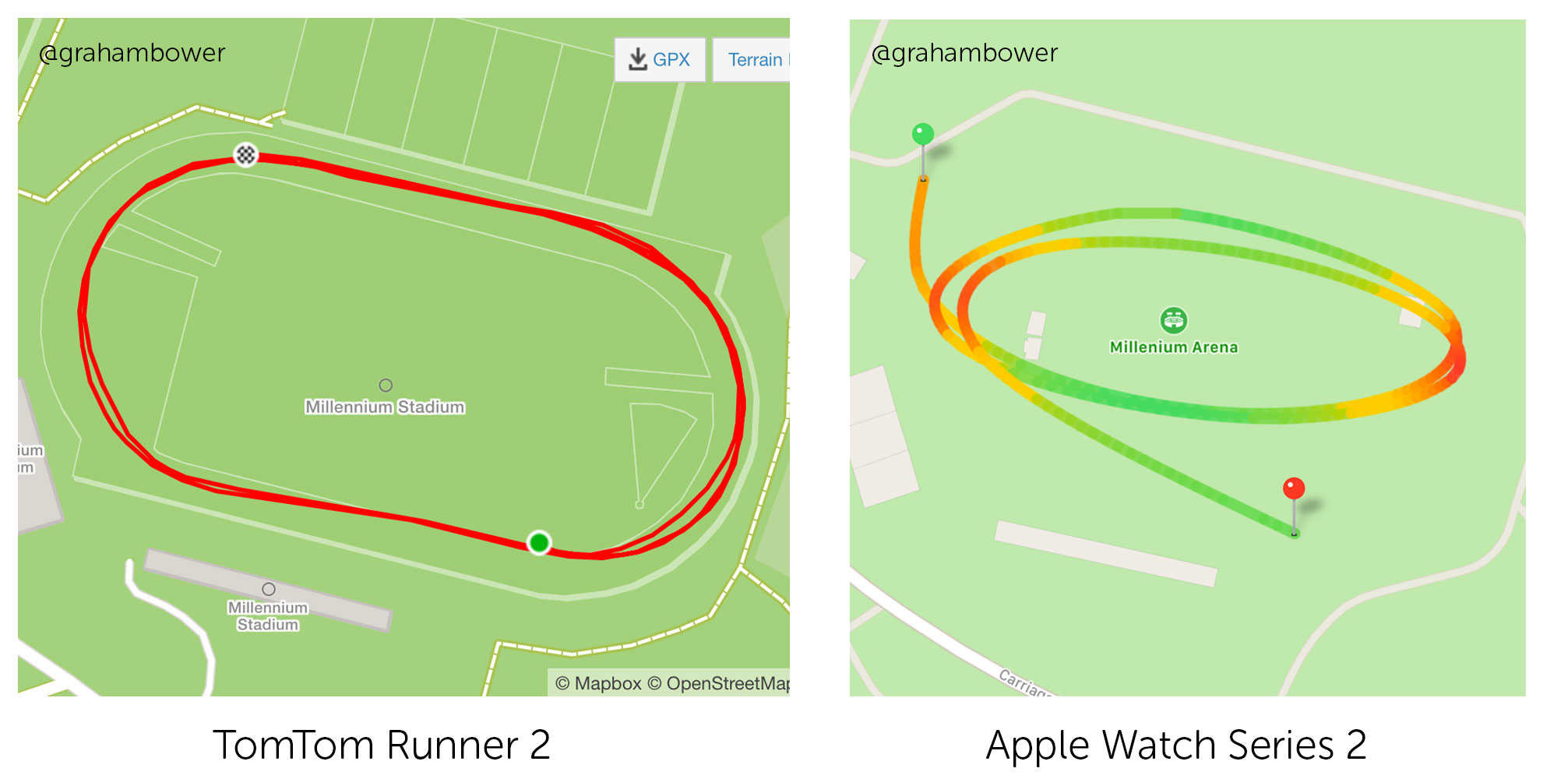
Photo: Graham Bower/Cult of Mac
It is odd that Apple Watch distance estimates can be so precise when its route mapping is so sketchy — it seems the mapping software is excessively simplifying the GPS data. Take this example of a road crossing: While the TomTom shows where and how I crossed the road in a lot of detail, Apple Watch smooths it out into a simple straight line.
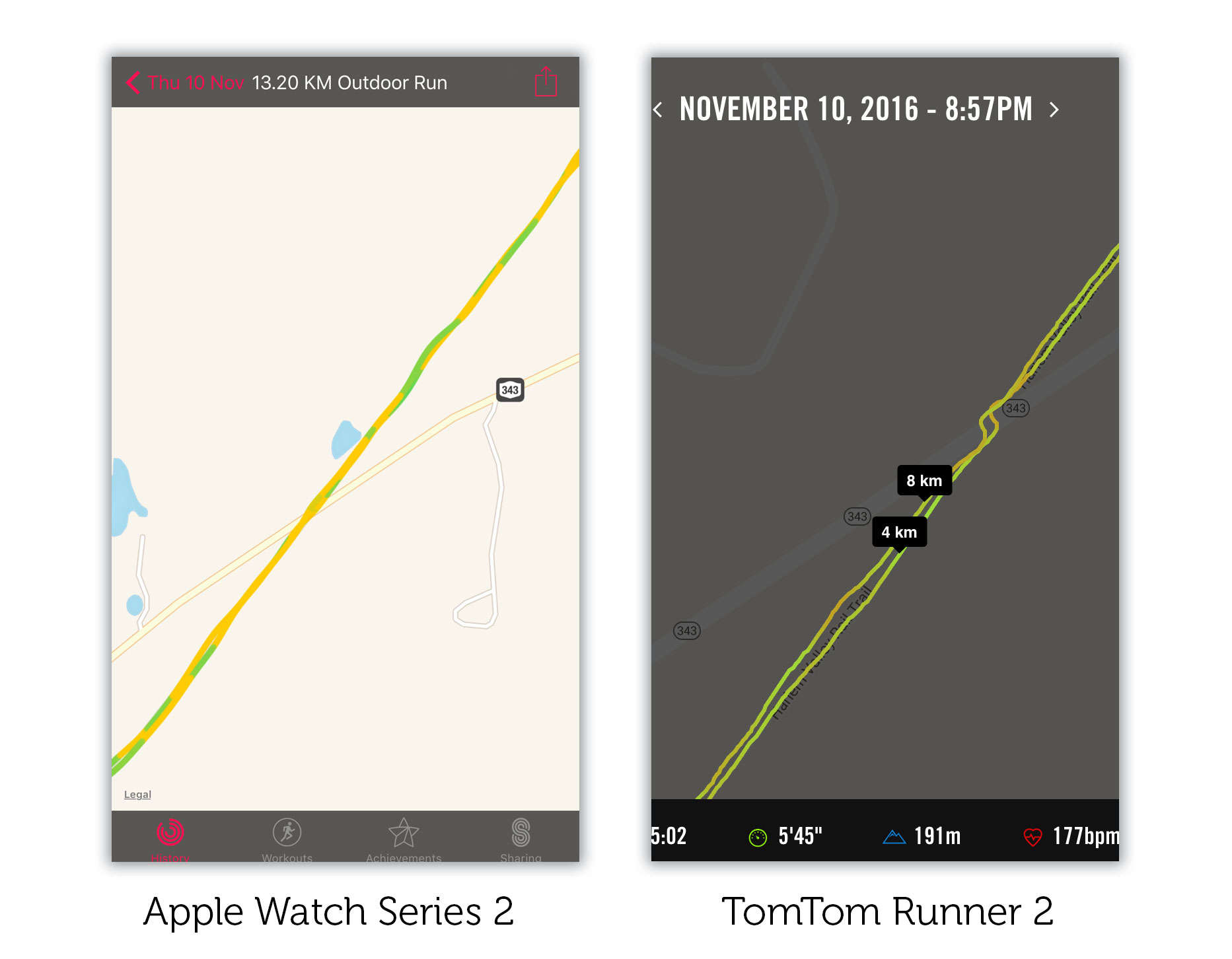
Photo: Graham Bower/Cult of Mac
Throughout my marathon training, Apple’s route mapping tended to oversimplify, meander off track, randomly pass through city blocks and even drift into rivers. TomTom’s route maps were consistently more reliable.
Location, location, location
Location appears to have a big impact. I did training runs in four different cities: Barcelona, Stockholm, London and New York. The city of Stockholm is built on an archipelago, with lots of islands separated by plenty of open space, while my running route in Barcelona takes me mostly along the beachfront. In both cases, Apple Watch’s mapping was fairly reliable.
But London and New York are larger, more built-up cities with lots of tall buildings. Here, Apple Watch’s mapping became far less reliable. For example, in midtown Manhattan, surrounded by skyscrapers, I found that large chunks of my run were simply not mapped at all. This is known as “urban canyon” interference — and it affects all GPS devices. But my TomTom handled these conditions better, providing reasonably accurate mapping where my Apple Watch did not.

Photo: Graham Bower/Cult of Mac
Does mapping accuracy affect distance estimates?
For most runners, route maps are just a fun reminder of past runs, and their accuracy is not that important. It’s the distance, time and pace metrics that really count.
Most of the mapping glitches I’m describing are only noticeable if you zoom into the map and take a close look, so they are arguably not that important. But I was concerned that they may be impacting Apple’s Watch’s distance estimates. My running track test had shown that Apple Watch was highly accurate at distance estimates despite its poor route mapping. But what about in more typical running routes that take you through city streets with intermittent GPS reception?
Without the precision of the running track, it is hard to know for sure how long your running route is. So instead, I looked at the consistency of my watches’ distance estimates when I completed multiple runs following exactly the same route. The same route should result in the same estimate. Any variance in distance is therefore an indication of inaccuracy.
I used three different routes for this test — one in Barcelona, one in Stockholm and one in London. The table below shows the distance estimates I got from my Apple Watch and TomTom.

Photo: Graham Bower/Cult of Mac
Both watches proved reasonably consistent, but Apple Watch varied more than TomTom, especially in London, where I got one particularly inaccurate result (on October 12). This may indicate that my Apple Watch is less accurate than my TomTom in built-up areas, although I’ll need to do more testing to confirm this.
Getting a GPS signal: Where do we start?
Unlike every other GPS device I have ever encountered, Apple Watch Series 2 provides no indication of GPS signal strength. It does not even pause to acquire a GPS location before letting you begin a workout. Apple claims it somehow “picks up a signal right away.”
Not having to wait to begin your run is a really great feature. With other watches I’ve used, it sometimes takes several minutes before they are ready.
But since GPS signal strength appears have a significant impact on Apple Watch’s route mapping accuracy, I think it would helpful if it gave you an indication of signal strength at the start of your run, and let you the choose whether to make a quick start and risk not getting a complete route map, or wait for the GPS signal to improve.
Running a marathon with Apple Watch
The biggest challenge that most runners will undertake is a marathon. The grueling distance of 26.2 miles tests you to the limit, and it is no picnic for a running watch, either.
During a marathon, you depend upon your running watch. It is an essential tool for keeping an eye on your pace, to ensure you stick to your race plan. And when you cross the finish line, you want your watch to record your achievement in all its glory.
When logging a workout, Apple Watch is continually using its GPS and heart rate sensors, which could drain the battery pretty quickly. So I was concerned that it might not last the full marathon. I’m happy to report, however, that both myself and my Apple Watch made it all the way to the finish line this year. In fact, my Apple Watch kept on running for the rest of the day as well, although admittedly I had a well-earned early night.
If you are likely to take five hours or more to complete your marathon, Apple recommends that you enable the Workout app’s Power Saving Mode (you turn on the switch in the Watch app on your iPhone). This will disable heart rate monitoring during your race, but at least your battery has a better chance of making it to the finish.
But for me this wasn’t necessary. The only issue I encountered during the race was when I spilled Gatorade on the watch at a drink station, which jammed up the Digital Crown. It’s not been quite the same since.

Photo: Graham Bower/Cult of Mac
After the race, I was surprised and a little disappointed that Apple Watch seemed not to notice that I had just logged a marathon. Given that Apple is now targeting runners, I think the Activity app’s “Achievements” should include medals for popular running distances like 10K, half-marathon and full marathon.
In contrast, when I uploaded the run from my TomTom, Strava automatically recognized not just the distance, but the race as well, sending me a congratulatory email for completing the TCS New York City Marathon.
Apple’s route map of the race was also a little disappointing: Its awkward yellow-on-yellow color scheme makes it difficult to see. Nike’s mapping proved to be much clearer.
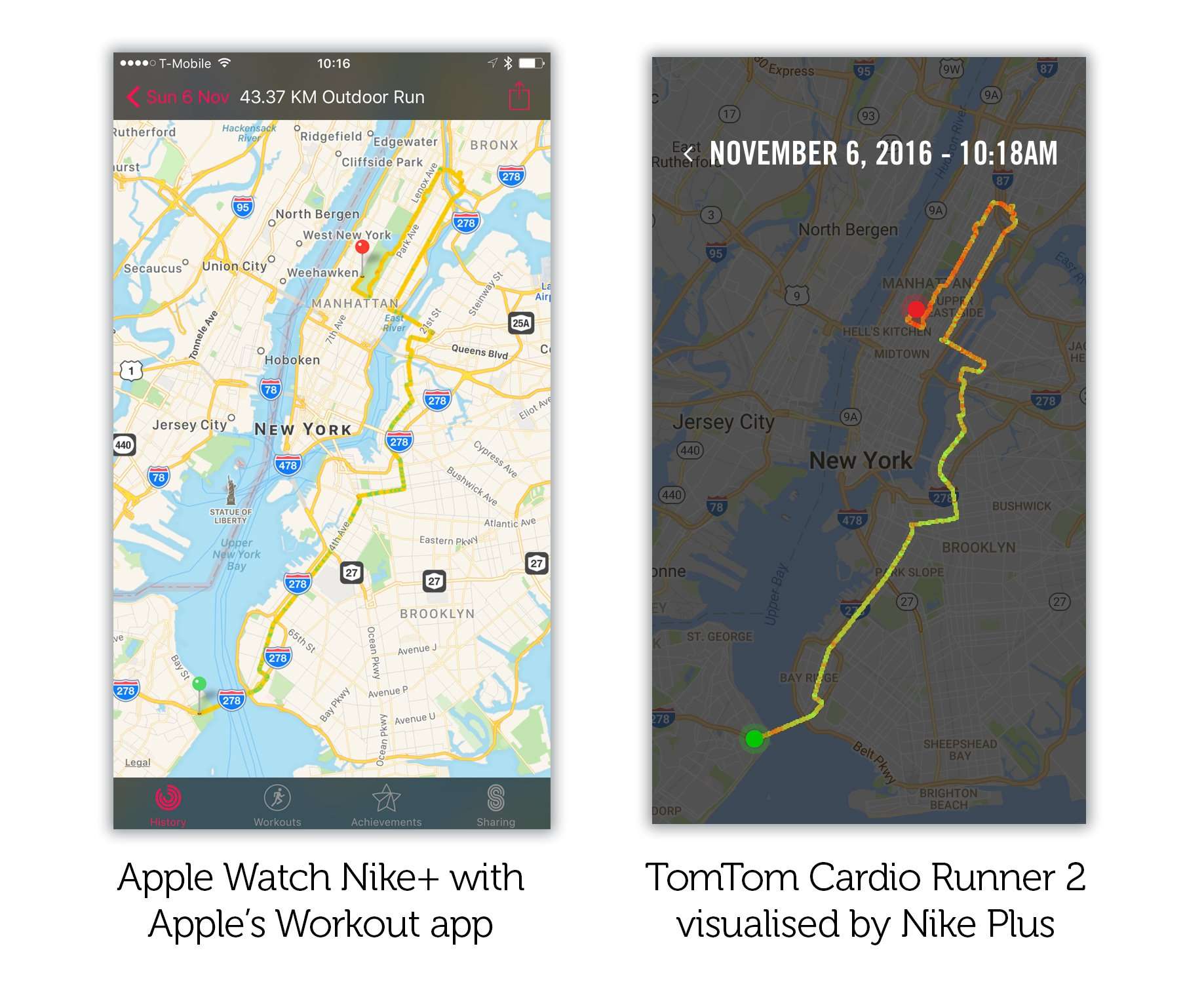
Photo: Graham Bower/Cult of Mac
A marathon course is 42.19 kilometers long. But in reality, when you run a marathon you end up going a little farther, as you navigate your way through the crowd. Apple Watch estimated my distance for the race to be 43.37 kilometers, while my TomTom came in at 43.07 kilometers. There is no way of knowing for sure which was most accurate, but my guess is TomTom was closer, since Apple’s 1.18-kilometer variance is a lot to be accounted for simply be weaving through the crowd.
Is the display such a bright idea?
Apple has doubled the brightness of the Series 2 display, which improves its visibility when you are running in sunny weather, although I find it more difficult to read than the reflective LCD displays more commonly found in other running watches. For nighttime runs, however, it is perfect — the best display I’ve used by far.
As with the original Apple Watch, there is still a lag when you raise your wrist, as you wait for the screen to wake up. This proves particularly problematic for runners, since it results in you taking your eye off the road ahead for longer. The good news, however, is that you no longer encounter a double-lag, waiting for the app to refresh once the screen has woken. Thanks to improvements in watchOS 3.1, even third-party apps like Nike+ Run Club now show the latest stats immediately.
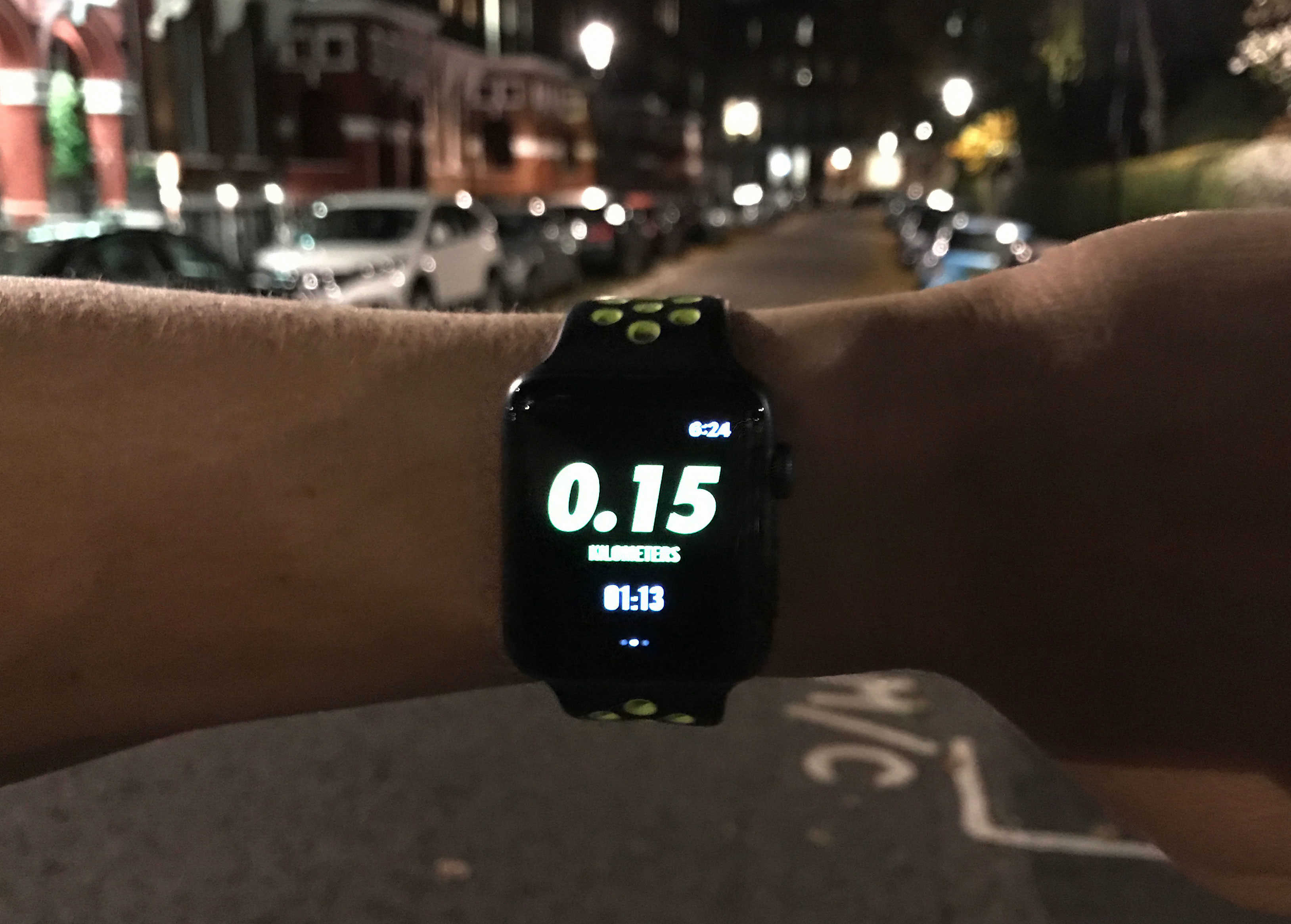
Photo: Graham Bower/Cult of Mac
It’s not just about the watch
There’s more to a good running watch than what goes on your wrist. Its primary purpose is to collect data, so what happens to the data when you finish a run is very important. And this is currently a major area of weakness for Apple Watch.
There is no iPhone companion for the Workout app. Instead, all workouts are saved into the Activity app on your phone, where they get lost. You will find a basic list of all your runs, but that’s about it. There are no charts nor interesting stats to show your progress. One essential feature I would expect to see in any running app is a chart of the daily distance you run — but even that is missing.
Route maps are oddly hidden. You will only find them only if you look at an individual run, down at the bottom of the screen in a tiny square you must tap to enlarge. Worse still, maps do not appear right away — it can take several minutes after a run for them to show. While you are waiting, the Activity app gives no indication of progress, or even whether the map will ever turn up.
When you do find a map, the detail available is very basic. It would be nice to have the option to see mile or kilometer markers along the route, plus elevation, heart rate and pace charts alongside the map. I think Apple could really go to town with this feature, integrating its impressive Flyover 3D maps to create cool animations of your route.
Granted, this is just version 1.0 of Apple’s route mapping. Hopefully we’ll see more features and innovation in subsequent software updates. In the meantime, there is always the option of using third-party watch apps instead.
Nike plus Apple: This watch ain’t big enough for the both of us
While there are some minor differences in the setup process of the Nike Apple Watch, from a software perspective, it is essentially the same as every other Series 2 model.
[contextly_auto_sidebar]
With the original Nike+ Apple partnership, Nike’s running app was genuinely integrated into the iPod. When you logged a run, you used the Nike+ app, and it synced to the Nike website. With Nike Apple Watch, however, it is not that simple. Oddly, it comes with two separate workout apps — one from Nike and one from Apple.
Apple says it wants to give users the choice of which app to use. But wouldn’t it be far better if the user did not have to choose at all? On a joint-branded device like this, I expected a more integrated solution, allowing me to use Apple’s built-in Workout app and still see my runs synced to the Nike+ website.
If you choose to use the Nike Run Club app instead of the built-in Workout app, your workouts will still appear in Apple’s Activity app, but only like any other third-party app, and the maps will not be included.
This is ultimately the issue. Apple seems to think of Nike Run Club as a third-party app. But on a Nike-branded watch, it should be a fully integrated first-party app.
This disconnect between Apple and Nike is evident throughout the watch user interface. If you log a run using Apple’s app, it does not appear on Nike’s “Last Run” complication. Whenever I finished a run with the Nike Run Club app, Nike’s attaboy message was immediately concealed by a competing attaboy notification from Apple’s Activity app. Even the color scheme of watchOS appears a little jarring next to the Volt color of the Nike watch face.
Ultimately it feels like two companies competing for your attention on a single device, and it lacks the seamless elegance of the original Nike+iPod partnership.
I’m still wearing two watches when I run
For the past year, I’ve been wearing two watches when I go for a run. My Apple Watch (because I’m an Apple fanboy) and my TomTom (because I want GPS data). I had assumed that when I bought an Apple Watch Series 2, I would finally be able to ditch my TomTom.
I love the design of my Nike Apple Watch, and the accuracy and mapping are good enough for my needs. But I’m sticking with two watches for now.
Why? Because Apple Watch does not currently give me direct access to my running data.
Most GPS running watches allow you to export GPX files, so you have the freedom to share and upload your workout data, including route maps, to any running website you like. When I finish a run with my TomTom, it even syncs my workouts to Strava, RunKeeper, Runtastic and Nike+ automatically. My friends can see my workouts, regardless of which running app they use.
In contrast, when you finish a workout with Apple Watch, your data is locked into the Activity app or the Nike Run Club app, with no option to export it. In time, third-party apps may solve this as they get updated for watchOS 3, but I would prefer to be able to use Apple’s built-in Workout app.
Apple continually improves its products, and this is just the first version of its GPS running watch. The great advantage that Apple has with watchOS is that the company can deliver regular software updates. On the top of my wishlist for future updates are:
- improved mapping with more detail
- a GPS signal strength indicator when you start a workout
- tighter Nike+ integration for the built-in Workout app
- a Workout companion app for iPhone with detailed workout analytics
- the option to export workouts as GPX files
Until then, I’ll still be wearing two watches when I run.
